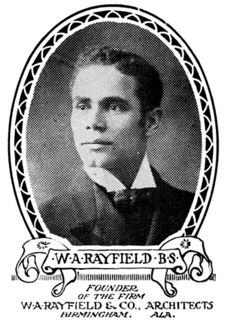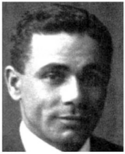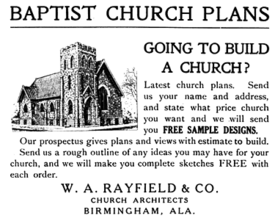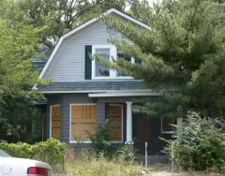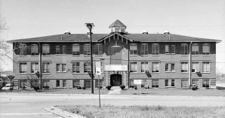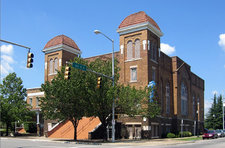Wallace Rayfield: Difference between revisions
Gene Wilson (talk | contribs) (→Birmingham: removed duplicate entry) |
|||
| (19 intermediate revisions by 2 users not shown) | |||
| Line 10: | Line 10: | ||
After graduating from Howard in [[1896]], Rayfield moved to Brooklyn, New York to study at the Pratt Polytechnic Institute. He received his certificate from that program in [[1898]] and then continued his studies for one year at Columbia University, earning his bachelor of architecture in [[1899]]. | After graduating from Howard in [[1896]], Rayfield moved to Brooklyn, New York to study at the Pratt Polytechnic Institute. He received his certificate from that program in [[1898]] and then continued his studies for one year at Columbia University, earning his bachelor of architecture in [[1899]]. | ||
While still a student at Columbia, Rayfield was recruited by Booker T. Washington to direct the Architectural and Mechanical Drawing Department at [[Tuskegee | While still a student at Columbia, Rayfield was recruited by Booker T. Washington to direct the Architectural and Mechanical Drawing Department at [[Tuskegee University|Tuskegee Institute]] ({{Locate coords inline | lat = 32.431389 | lon = -85.706667 | zoom = 7 | type = m}}) in Alabama. He began in the Fall of 1899 directing courses in mechanical and architectural drawing. He compiled and printed an ''Industrial Drawing Book'' with drafting exercises for students. Over ten years at Tuskegee he raised the program from a modest instruction in drafting to a well-respected course of architectural study. Many African-American architects began their studies at Tuskegee. | ||
Complaining of low pay, but perhaps motivated by the treatment given to colleague [[Wallace Pittman]], Rayfield resigned from the Institute in [[1907]] and opened a professional office in Birmingham. Before leaving Tuskegee he had already launched a business marketing mail-order plans nationwide. He advertised "branch offices" in Birmingham, Montgomery, Mobile, Talladega, Atlanta, Savannah, and Augusta. In the same year he married his first wife, Jennie Hutchins, a Tuskegee student from Clarksville, Tennessee. | Complaining of low pay, but perhaps motivated by the treatment given to colleague [[Wallace Pittman]], Rayfield resigned from the Institute in [[1907]] and opened a professional office in Birmingham. Before leaving Tuskegee he had already launched a business marketing mail-order plans nationwide. He advertised "branch offices" in Birmingham, Montgomery, Mobile, Talladega, Atlanta, Savannah, and Augusta. In the same year he married his first wife, [[Jennie Rayfield|Jennie Hutchins]], a Tuskegee student from Clarksville, Tennessee. | ||
==Birmingham== | ==Birmingham== | ||
Rayfield left Tuskegee Institute and moved to Birmingham in [[1908]] to focus on his young practice. He brought with him glowing letters of recommendation from Washington and secured a $40 commission on his first day in the city. He appeared in the city directory of that year at his residence at 109 Corrilla Street (now [[Center Place South]]). Later that year he constructed his own residence at 105 [[1st | Rayfield left Tuskegee Institute and moved to Birmingham in [[1908]] to focus on his young practice. He brought with him glowing letters of recommendation from Washington and secured a $40 commission on his first day in the city. He appeared in the city directory of that year at his residence at 109 Corrilla Street (now [[Center Place South]]). Later that year he constructed his own residence at 105 [[1st Street South]] in [[Titusville]]. The house was designed, financed and constructed entirely within the African American community (one of only 10 such houses in Birmingham, according to historian [[Phillip W. Holland]]). The home featured a large stained glass window and a special "architectural room" surrounded by windows in the attic level. Mr & Mrs Rayfield raised a daughter, [[Edith Rayfield|Edith]] there, attending [[Saint Mark's Episcopal Church]]. Mrs Rayfield died in [[1929]] and was interred at [[Grace Hill Cemetery]]. | ||
During the Depression it was impossible to keep ahead of business. On [[March 1]], [[1932]] he married widow [[Bessie Fulwood Rogers]], who was herself employed by Dr [[Edmund Rucker | During the Depression it was impossible to keep ahead of business. On [[March 1]], [[1932]] he married widow [[Bessie Fulwood Rogers]], who was herself employed by Dr [[Edmund Rucker Jr]]. Rayfield resided with her at 328 [[Iota Avenue]], a few blocks from his former home. Rayfield was the leader of the group of prominent Black citizens that founded the [[South Elyton Civic League]] for the improvement of the Titusville community. | ||
In his later years, Rayfield joined the [[Immaculate Conception Catholic Church]] on [[6th Avenue South]]. He suffered declining health and died of a stroke at his home at the end of February 1941. He is interred at [[Greenwood Cemetery]] in [[Woodlawn]]. | In his later years, Rayfield joined the [[Immaculate Conception Catholic Church]] on [[6th Avenue South]]. He suffered declining health and died of a stroke at his home at the end of February 1941. He is interred at [[Greenwood Cemetery]] in [[Woodlawn]]. | ||
==Professional career== | ==Professional career== | ||
[[Image:Trinity Baptist Church rendering.jpg|left|thumb| | [[Image:Trinity Baptist Church rendering.jpg|left|thumb|275px|Rendering of [[Trinity Baptist Church]] by W. A. Rayfield & Co.]] | ||
In addition to his personal office at home, Rayfield owned a series of downtown offices. The City Directory lists these as: 1717 1/2 [[3rd Avenue North]], 402 & 404 1/2 [[15th Street North]], the [[Alabama Penny Savings Bank Building]] (the [[Pythian Temple Building]] after [[1917]]), and the [[Colored Masonic Temple]]. According to his correspondence, he also kept offices in the [[Echols Building]] In [[ | In addition to his personal office at home, Rayfield owned a series of downtown offices. The City Directory lists these as: 1717 1/2 [[3rd Avenue North]], 402 & 404 1/2 [[15th Street North]], the [[Alabama Penny Savings Bank Building]] (the [[Pythian Temple Building]] after [[1917]]), and the [[Colored Masonic Temple]]. A [[1911]] book located his firm in the [[Mason Building]] at 1717 [[3rd Avenue North]]. According to his correspondence, he also kept offices in the [[Echols Building]]. In [[1913]] he was listed in partnership with [[Alphonso Reveron]]. He taught one year at [[Industrial High School]] in [[1919]]-[[1920|20]]. | ||
Rayfield received most of his commissions from churches. In [[1909]] he won a competition to serve a four-year term as official architect of the national [[African Methodist Episcopal Zion Church]], headquartered in Philadelphia, Pennsylvania. He was later elected Superintending Architect for the [[ | Rayfield received most of his commissions from churches. In [[1909]] he won a competition to serve a four-year term as official architect of the national [[African Methodist Episcopal Zion Church]], headquartered in Philadelphia, Pennsylvania. He was later elected Superintending Architect for the [[Freedmen's Aid Society]], headquartered in Cincinnati, Ohio. He also completed several residences in Birmingham and a number of school buildings. | ||
[[Image:W A Rayfield advertisement.png|right|thumb|275px|1919 advertisement for Rayfield's church designs]] | [[Image:W A Rayfield advertisement.png|right|thumb|275px|1919 advertisement for Rayfield's church designs]] | ||
While in Birmingham, Rayfield supervised the preparation of several plan books as marketing materials. These included ''The Southern Bungalow Book'', ''Book of Designs: Churches'', ''Designs for Lutheran Churches'', and ''The Fraternal Building''. He also compiled a directory of ''The Colored Mechanics of Birmingham, Ala.'' with information about numerous builders, carpenters, decorators and other tradesmen ready to serve the city's African-American clients. A | While in Birmingham, Rayfield supervised the preparation of several plan books as marketing materials. These included ''The Southern Bungalow Book'', ''Book of Designs: Churches'', ''Designs for Lutheran Churches'', and ''The Fraternal Building''. He also compiled a directory of ''The Colored Mechanics of Birmingham, Ala.'' with information about numerous builders, carpenters, decorators and other tradesmen ready to serve the city's African-American clients. | ||
Rayfield's business went into bankruptcy auction during the [[Great Depression]]. A set of 411 printing plates from his books and advertisements came into the hands of antique dealer [[Eston Hallmark]] and ended up in storage in a barn in [[McCalla]] owned by minister [[Allen Durough]]. When Durough discovered the collection in [[1993]] he considered it a God-given opportunity. He researched Rayfield extensively and published a monograph through the [[University of Alabama Press]] in [[2010]]. Durough died in [[2019]]. | |||
In [[2020]] filmmaker [[Dwight Cammeron]] completed a documentary entitled ''[[Finding the Cornerstone: The Wallace A. Rayfield Story]]'', which premiered at the [[2020 Sidewalk Film Festival]]. | |||
==Notable works== | ==Notable works== | ||
It is estimated that between his professional and mail-order architectural services, Rayfield was responsible for designing thousands of structures across the United States. | It is estimated that between his professional and mail-order architectural services, Rayfield was responsible for designing thousands of structures across the United States, with over 130 buildings in Birmingham alone. | ||
===Birmingham=== | ===Birmingham=== | ||
| Line 49: | Line 53: | ||
* [[Windham Building]], [[1912]] | * [[Windham Building]], [[1912]] | ||
* [[Pythian Temple]], [[1913]] | * [[Pythian Temple]], [[1913]] | ||
* [[R. A. Blount]] residence, [[ | * [[R. A. Blount]] residence, 1914 | ||
* [[Trinity Baptist Church]], [[Smithfield]], c. | * [[22nd Avenue Baptist Church]], [[Evergreen]], 1917 | ||
* [[Trinity Baptist Church]], [[Smithfield]], c. 1920 | |||
* [[Tuggle Institute]], [[1920]] | * [[Tuggle Institute]], [[1920]] | ||
* [[32nd Street Baptist Church]], [[1924]] | * [[32nd Street Baptist Church]], [[1924]] | ||
* [[Harmony Street Baptist Church]], [[North Avondale]], | * [[Harmony Street Baptist Church]], [[North Avondale]], 1924 | ||
* [[J. S. Jackson residence]], [[1925]] | * [[J. S. Jackson residence]], [[1925]] | ||
* [[St Luke African Methodist Episcopal Church]], [[North Birmingham]], 1926 | |||
* [[1st Congregational Church]] | * [[1st Congregational Church]] | ||
* [[Mount Ararat Baptist Church]], [[Ensley]] | * [[Mount Ararat Baptist Church]], [[Ensley]] | ||
| Line 63: | Line 69: | ||
* [[John Coar]] residence | * [[John Coar]] residence | ||
* [[John Commons]] residence | * [[John Commons]] residence | ||
* [[A. G. Dobbins]] residence | * [[A. G. Dobbins]] residence, [[1926]] | ||
* [[R. E. Pharrow]] residence | * [[R. E. Pharrow]] residence, [[1908]] | ||
* [[Dunbar Hotel]] | * [[Dunbar Hotel]] | ||
* [[ | * [[Black Elks Lodge]] at 800 [[12th Street North]], burned 2024 | ||
* [[Harriet Strong Undertaking Company]] building | * [[Harriet Strong Undertaking Company]] building | ||
* [[Indian Herb Drug Company]] building | * [[Indian Herb Drug Company]] building | ||
| Line 100: | Line 106: | ||
* Marlinton Presbyterian Church, Marlinton, West Virginia | * Marlinton Presbyterian Church, Marlinton, West Virginia | ||
* Methodist Episcopal Church, Fort Worth, Texas, [[1915]] | * Methodist Episcopal Church, Fort Worth, Texas, [[1915]] | ||
* Mount Gilead Baptist Church, Fort Worth, Texas | * Mount Gilead Baptist Church, Fort Worth, Texas, [[1912]] | ||
* Mount Pilgrim Baptist Church, Milton, Florida | * Mount Pilgrim Baptist Church, Milton, Florida | ||
* Mount Zion Baptist Church, Memphis, Tennessee, [[1918]] | * Mount Zion Baptist Church, Memphis, Tennessee, [[1918]] | ||
| Line 116: | Line 122: | ||
==References== | ==References== | ||
* Hamilton, G. P. (1911) "W. A. Rayfield, B. S., Birmingham, Ala." in ''[http://www.archive.org/details/beaconlightsofra00lchami Beacon Lights of the Race]''. Memphis, E. H. Clarke & Brother, pp. 451-7 | * Hamilton, G. P. (1911) "W. A. Rayfield, B. S., Birmingham, Ala." in ''[http://www.archive.org/details/beaconlightsofra00lchami Beacon Lights of the Race]''. Memphis, E. H. Clarke & Brother, pp. 451-457 | ||
* "Architect Dies" (March 7, 1941) ''[[Birmingham World]]'' | |||
* Brown, Charles A. (1972) ''W. A. Rayfield: Pioneer Black Architect of Birmingham, Ala.'' Birmingham: Gray Printing Company | * Brown, Charles A. (1972) ''W. A. Rayfield: Pioneer Black Architect of Birmingham, Ala.'' Birmingham: Gray Printing Company | ||
* Dozier, Richard Kevin (1990) ''Tuskegee: Booker T. Washington's Construbution to the Education of Black Architects.'' | * Dozier, Richard Kevin (1990) ''Tuskegee: Booker T. Washington's Construbution to the Education of Black Architects.'' PhD dissertations. University of Michigan. | ||
* McKenzie, Vinson. (Fall 1993) "[ | * McKenzie, Vinson E. (Fall 1993) "[https://usmodernist.org/FF/FF-1993-fall.pdf A Pioneering African-American Architect in Alabama: Wallace A. Rayfield, 1874-1941]." ''Journal of the Interfaith Forum on Religion, Art & Architecture.'' Vol. 13, pp. 12–14 | ||
* Dowling, Elizabeth Meredith (2004) "Wallace Augustus Rayfield (1874–1941)" in Derek Spurlock Wilson, ed. ''African-American Architects: A Biographical Dictionary, 1865-1945''. Taylor & Francis ISBN 9780415929592 | * Dowling, Elizabeth Meredith (2004) "Wallace Augustus Rayfield (1874–1941)" in Derek Spurlock Wilson, ed. ''African-American Architects: A Biographical Dictionary, 1865-1945''. Taylor & Francis ISBN 9780415929592 | ||
* Dozier, Richard; Bill Springer and Allen R. Durough (February 12, 2009) "Wallace Rayfield" panel presentation. "Collective Perspectives" series. Vulcan Park and Museum. | * Dozier, Richard; Bill Springer and Allen R. Durough (February 12, 2009) "Wallace Rayfield" panel presentation. "Collective Perspectives" series. Vulcan Park and Museum. | ||
| Line 125: | Line 132: | ||
* Sledge, John (August 12, 2010) "Southern Bound: An overdue look at architect Wallace Rayfield." ''Mobile Press-Register'' | * Sledge, John (August 12, 2010) "Southern Bound: An overdue look at architect Wallace Rayfield." ''Mobile Press-Register'' | ||
* Durough, Allan R. (2010) ''The Architectural Legacy of Wallace A. Rayfield: Pioneer Black Architect of Birmingham, Alabama.'' Tuscaloosa: University of Alabama Press ISBN 9780817316839 | * Durough, Allan R. (2010) ''The Architectural Legacy of Wallace A. Rayfield: Pioneer Black Architect of Birmingham, Alabama.'' Tuscaloosa: University of Alabama Press ISBN 9780817316839 | ||
* Ward, Logan (January/February 2011) "[ | * Ward, Logan (January/February 2011) "[http://web.archive.org/web/20120826011013/http://www.preservationnation.org/magazine/2011/january-february/rediscovering-mr-rayfield.html Rediscovering Mr. Rayfield: The legacy of a pioneering African American architect is being restored by an indefatigable Southern Baptist preacher]" ''Preservation Magazine'' archived August 26, 2012 | ||
* Qualls, Shirley (June 25, 1985) ''[http://npgallery.nps.gov/GetAsset/51cab34a-db20-429e-954b-7fb1b3475d4a National Register of Historic Places - Nomination Form]'' ''National Park Service'' retrieved June 3, 2017 | |||
* Sharpe-Jefferson, Keisa (January 12, 2024) "[https://www.birminghamtimes.com/2024/01/how-a-filmmaker-discovered-wallace-a-rayfield-architect-of-birminghams-historic-sanctuaries/ Filmmaker Discovers a Pioneer Black Architect of Birmingham’s Historic Sanctuaries]." {{BT}} | |||
{{DEFAULTSORT:Rayfield, Wallace}} | {{DEFAULTSORT:Rayfield, Wallace}} | ||
[[Category:1872 births]] | [[Category: 1872 births]] | ||
[[Category:1941 deaths]] | [[Category: 1941 deaths]] | ||
[[Category:Architects]] | [[Category: Architects]] | ||
[[Category:Tuskegee faculty]] | [[Category: Wallace Rayfield buildings|*]] | ||
[[Category:Parker faculty]] | [[Category: Tuskegee faculty]] | ||
[[Category:Entrepreneurs]] | [[Category: Parker faculty]] | ||
[[Category:Stroke deaths]] | [[Category: Entrepreneurs]] | ||
[[Category:Greenwood burials]] | [[Category: Mason Building]] | ||
[[Category: Iota Avenue]] | |||
[[Category: Stroke deaths]] | |||
[[Category: Greenwood burials]] | |||
Latest revision as of 13:47, 28 February 2024
Wallace Augustus Rayfield (born March 10, 18731 in Bibb County, Georgia; died February 28, 1941 in Birmingham) was the second formally-educated practicing African American architect in the United States, preceded only by Robert Robinson Taylor. He led the architecture department at Tuskegee Institute, and maintained a professional design practice. He is responsible for numerous notable structures in Birmingham and was appointed superintending architect for the Freedmen's Aid Society and chief architect of the African Methodist Episcopal Zion Church. He also extended his practice across the United States and overseas through the sale of mail order plans and plan books.
Early life and career
Rayfield's father was a railroad porter and high school teacher, and his mother a graduate of Atlanta University who worked as a maid. He grew up in Macon, Georgia and attended the Lewis School there, taking particular interest in a course on cartography. He went on to study at the Ballard Normal School, where his father taught, before moving to Washington D. C. to live with an aunt after his mother died.
Rayfield continued his studies at the preparatory school for Howard University. While there, he befriended Miss D. L. Mussey, daughter of the attorney representing the noted architectural office of A. B. Mullett and Company. Through that connection Rayfield secured a position with the firm where over two years he gained both practical experience and a strong desire to pursue a career in architecture.
After graduating from Howard in 1896, Rayfield moved to Brooklyn, New York to study at the Pratt Polytechnic Institute. He received his certificate from that program in 1898 and then continued his studies for one year at Columbia University, earning his bachelor of architecture in 1899.
While still a student at Columbia, Rayfield was recruited by Booker T. Washington to direct the Architectural and Mechanical Drawing Department at Tuskegee Institute (map) in Alabama. He began in the Fall of 1899 directing courses in mechanical and architectural drawing. He compiled and printed an Industrial Drawing Book with drafting exercises for students. Over ten years at Tuskegee he raised the program from a modest instruction in drafting to a well-respected course of architectural study. Many African-American architects began their studies at Tuskegee.
Complaining of low pay, but perhaps motivated by the treatment given to colleague Wallace Pittman, Rayfield resigned from the Institute in 1907 and opened a professional office in Birmingham. Before leaving Tuskegee he had already launched a business marketing mail-order plans nationwide. He advertised "branch offices" in Birmingham, Montgomery, Mobile, Talladega, Atlanta, Savannah, and Augusta. In the same year he married his first wife, Jennie Hutchins, a Tuskegee student from Clarksville, Tennessee.
Birmingham
Rayfield left Tuskegee Institute and moved to Birmingham in 1908 to focus on his young practice. He brought with him glowing letters of recommendation from Washington and secured a $40 commission on his first day in the city. He appeared in the city directory of that year at his residence at 109 Corrilla Street (now Center Place South). Later that year he constructed his own residence at 105 1st Street South in Titusville. The house was designed, financed and constructed entirely within the African American community (one of only 10 such houses in Birmingham, according to historian Phillip W. Holland). The home featured a large stained glass window and a special "architectural room" surrounded by windows in the attic level. Mr & Mrs Rayfield raised a daughter, Edith there, attending Saint Mark's Episcopal Church. Mrs Rayfield died in 1929 and was interred at Grace Hill Cemetery.
During the Depression it was impossible to keep ahead of business. On March 1, 1932 he married widow Bessie Fulwood Rogers, who was herself employed by Dr Edmund Rucker Jr. Rayfield resided with her at 328 Iota Avenue, a few blocks from his former home. Rayfield was the leader of the group of prominent Black citizens that founded the South Elyton Civic League for the improvement of the Titusville community.
In his later years, Rayfield joined the Immaculate Conception Catholic Church on 6th Avenue South. He suffered declining health and died of a stroke at his home at the end of February 1941. He is interred at Greenwood Cemetery in Woodlawn.
Professional career

In addition to his personal office at home, Rayfield owned a series of downtown offices. The City Directory lists these as: 1717 1/2 3rd Avenue North, 402 & 404 1/2 15th Street North, the Alabama Penny Savings Bank Building (the Pythian Temple Building after 1917), and the Colored Masonic Temple. A 1911 book located his firm in the Mason Building at 1717 3rd Avenue North. According to his correspondence, he also kept offices in the Echols Building. In 1913 he was listed in partnership with Alphonso Reveron. He taught one year at Industrial High School in 1919-20.
Rayfield received most of his commissions from churches. In 1909 he won a competition to serve a four-year term as official architect of the national African Methodist Episcopal Zion Church, headquartered in Philadelphia, Pennsylvania. He was later elected Superintending Architect for the Freedmen's Aid Society, headquartered in Cincinnati, Ohio. He also completed several residences in Birmingham and a number of school buildings.
While in Birmingham, Rayfield supervised the preparation of several plan books as marketing materials. These included The Southern Bungalow Book, Book of Designs: Churches, Designs for Lutheran Churches, and The Fraternal Building. He also compiled a directory of The Colored Mechanics of Birmingham, Ala. with information about numerous builders, carpenters, decorators and other tradesmen ready to serve the city's African-American clients.
Rayfield's business went into bankruptcy auction during the Great Depression. A set of 411 printing plates from his books and advertisements came into the hands of antique dealer Eston Hallmark and ended up in storage in a barn in McCalla owned by minister Allen Durough. When Durough discovered the collection in 1993 he considered it a God-given opportunity. He researched Rayfield extensively and published a monograph through the University of Alabama Press in 2010. Durough died in 2019.
In 2020 filmmaker Dwight Cammeron completed a documentary entitled Finding the Cornerstone: The Wallace A. Rayfield Story, which premiered at the 2020 Sidewalk Film Festival.
Notable works
It is estimated that between his professional and mail-order architectural services, Rayfield was responsible for designing thousands of structures across the United States, with over 130 buildings in Birmingham alone.
Birmingham
- Edward Brown residence, 1907
- Arthur Brown residence, 1907
- A. H. Parker residence, 1907
- Ed Pharrow residence, 1908
- Wallace Rayfield residence, 1908
- 6th Avenue Baptist Church, 1910
- Thomas School, 1910
- 16th Street Baptist Church, 1911
- T. S. Jackson residence, 1912
- Stewart Hall, Miles College, 1912
- Windham Building, 1912
- Pythian Temple, 1913
- R. A. Blount residence, 1914
- 22nd Avenue Baptist Church, Evergreen, 1917
- Trinity Baptist Church, Smithfield, c. 1920
- Tuggle Institute, 1920
- 32nd Street Baptist Church, 1924
- Harmony Street Baptist Church, North Avondale, 1924
- J. S. Jackson residence, 1925
- St Luke African Methodist Episcopal Church, North Birmingham, 1926
- 1st Congregational Church
- Mount Ararat Baptist Church, Ensley
- Sardis Baptist Church
- South Elyton Baptist Church
- R. T. Brown residence
- Madame Clisby residence ("The Gables") at 714 14th Street South
- John Coar residence
- John Commons residence
- A. G. Dobbins residence, 1926
- R. E. Pharrow residence, 1908
- Dunbar Hotel
- Black Elks Lodge at 800 12th Street North, burned 2024
- Harriet Strong Undertaking Company building
- Indian Herb Drug Company building
- Hill Top (Smith-Gaston Residence), Fairfield
- Charles T. Mabry residence
- Metropolitan A.M.E. Zion Church
- O. K. French Cleaners building
- R. W. Seymour residence
- T. S. Strawbridge residence
- Walton's Cafe
Elsewhere in Alabama
- Bailey's Tabernacle Baptist Church, Tuscaloosa
- First Congregational Church, Talladega College, Talladega
- First Missionary Baptist Church, Decatur, 1921
- Foster Hall, Selma University, Selma, 1910
- Hunter Chapel AME Zion Church, Tuscaloosa
- Morning Star Baptist Church, Demopolis, Alabama, 1920
- St Paul AME Church, Tuscaloosa
- Stone Street Baptist Church, Mobile, 1930
- Weeping Mary Baptist Church, Tuscaloosa
Outside Alabama
- Antioch Baptist Church, Cincinnati, Ohio
- Ebenezer Baptist Church, Chicago, Illinois
- First Church of Christ Scientist, Charleston, West Virginia, 1915
- Guadalupe College, Seguin, Texas, 1923
- Haven Institute Dormitory, Meridian, Mississippi
- Heroden Baptist Church, Vicksburg, Mississippi, 1919
- Independent Benevolent Order Home Office Building, Atlanta, Georgia
- Macedonia Baptist Church, Dallas, Texas, 1916
- Marlinton Methodist Church, Marlinton, West Virginia
- Marlinton Presbyterian Church, Marlinton, West Virginia
- Methodist Episcopal Church, Fort Worth, Texas, 1915
- Mount Gilead Baptist Church, Fort Worth, Texas, 1912
- Mount Pilgrim Baptist Church, Milton, Florida
- Mount Zion Baptist Church, Memphis, Tennessee, 1918
- Mount Zion Baptist Church, Pensacola, Florida
- Public school, Paco, Texas
- St John's Church, Dallas, Texas, 1918
- St Paul's Episcopal Church, Batesville, Arkansas, 1924
- Trinity Building, South Africa
- Trinity African Methodist Episcopal Church, Spartanburg, South Carolina 1922
Notes
- This is the date Rayfield inscribed on his draft registration. Other sources give a range of dates from 1872 to May 10, 1874.
References
- Hamilton, G. P. (1911) "W. A. Rayfield, B. S., Birmingham, Ala." in Beacon Lights of the Race. Memphis, E. H. Clarke & Brother, pp. 451-457
- "Architect Dies" (March 7, 1941) Birmingham World
- Brown, Charles A. (1972) W. A. Rayfield: Pioneer Black Architect of Birmingham, Ala. Birmingham: Gray Printing Company
- Dozier, Richard Kevin (1990) Tuskegee: Booker T. Washington's Construbution to the Education of Black Architects. PhD dissertations. University of Michigan.
- McKenzie, Vinson E. (Fall 1993) "A Pioneering African-American Architect in Alabama: Wallace A. Rayfield, 1874-1941." Journal of the Interfaith Forum on Religion, Art & Architecture. Vol. 13, pp. 12–14
- Dowling, Elizabeth Meredith (2004) "Wallace Augustus Rayfield (1874–1941)" in Derek Spurlock Wilson, ed. African-American Architects: A Biographical Dictionary, 1865-1945. Taylor & Francis ISBN 9780415929592
- Dozier, Richard; Bill Springer and Allen R. Durough (February 12, 2009) "Wallace Rayfield" panel presentation. "Collective Perspectives" series. Vulcan Park and Museum.
- Boyd, Ashley (January 31, 2010) "Work of Tuscaloosa's first black architect shines in churches." Tuscaloosa News
- Sledge, John (August 12, 2010) "Southern Bound: An overdue look at architect Wallace Rayfield." Mobile Press-Register
- Durough, Allan R. (2010) The Architectural Legacy of Wallace A. Rayfield: Pioneer Black Architect of Birmingham, Alabama. Tuscaloosa: University of Alabama Press ISBN 9780817316839
- Ward, Logan (January/February 2011) "Rediscovering Mr. Rayfield: The legacy of a pioneering African American architect is being restored by an indefatigable Southern Baptist preacher" Preservation Magazine archived August 26, 2012
- Qualls, Shirley (June 25, 1985) National Register of Historic Places - Nomination Form National Park Service retrieved June 3, 2017
- Sharpe-Jefferson, Keisa (January 12, 2024) "Filmmaker Discovers a Pioneer Black Architect of Birmingham’s Historic Sanctuaries." The Birmingham Times
